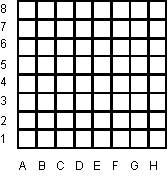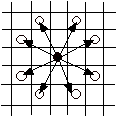IOI '98 P5 - Camelot
View as PDFIOI '98 - Setúbal, Portugal
Centuries ago, King Arthur and the Knights of the Round Table used to meet every year on New Year's Day to celebrate their fellowship. In remembrance of these events, we consider a board game for one player, on which one king and several knight pieces are placed at random on distinct squares.
The Board is an 8x8 array of squares.

Figure 1. A board
The King can move to any adjacent square from
 to
to
 ,
as shown in Figure 2, as long as it does not fall off the board.
,
as shown in Figure 2, as long as it does not fall off the board.

Figure 2. All possible movements of the king
A Knight can jump from
 to
to
 ,
as shown in Figure 3, as long as it does not fall off the board.
,
as shown in Figure 3, as long as it does not fall off the board.

Figure 3. All possible movements of a knight
During the play, the player can place more than one piece in the same square. The board squares are assumed big enough so that a piece is never an obstacle for other piece to move freely.
The player's goal is to move the pieces so as to gather them all in the same square, in the smallest possible number of moves. To achieve this, he must move the pieces as prescribed above. Additionally, whenever the king and one or more knights are placed in the same square, the player may choose to move the king and one of the knights together henceforth, as a single knight, up to the final gathering point. Moving the knight together with the king counts as a single move.
Write a program to compute the minimum number of moves the player must perform to produce the gathering.
Input Specification
The input contains the initial board configuration, encoded as a
character string. The string contains a sequence of up to distinct
board positions, being the first one the position of the king and the
remaining ones those of the knights
number of knights
. Each
position is a letter-digit pair. The letter indicates the horizontal
board coordinate, the digit indicates the vertical board coordinate.
Output Specification
The output must contain a single line with an integer indicating the minimum number of moves the player must perform to produce the gathering.
Sample Input
D4A3A8H1H8The king is positioned at . There are four knights, positioned at
,
,
, and
.
Sample Output
10
Comments